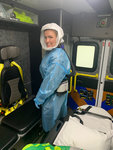

After several months of waiting, the Pettis County Ambulance District (PCAD) staff has received 17 Powered Air Purifying Respirator (PAPR) devices to better communicate with patients during patient care and transport and 12 LUCAS systems to use when performing CPR.
A PAPR is personal protective equipment for health care workers that has a hood with a clear shield with airflow and filtration features. It allows people who wear them to breathe more naturally while feeling a constant airflow in the headtop.
PCAD EMS Chief Eric Dirck said he and his team are training staff on the proper use and decontamination of the devices, and he anticipates primarily using them for inter-facility transfers due to extended time with patients.
“One of the major advantages of the PAPR is the ability to communicate more effectively and personally during a long trip to another hospital,” he said. “Being able to see a provider’s face can be especially helpful, as facial expressions play a major role in how we communicate.”
Dirck said each of the district’s eight daily staffed ambulances has two devices on board for a total of 16 active devices. There also is one backup PAPR available. The cost for each device was $1,400 for a total of about $24,000.
Another important piece of equipment to PCAD is 12 LUCAS mechanical chest compression units to help with performing CPR. The PCAD Board of Directors approved the purchase of the units at its October meeting at a total cost of $197,000, which includes the devices, cases, chargers and extra batteries.
Use of a LUCAS system has been shown to improve the quality and consistency of chest compressions, increase oxygen levels, as well as provide sustained life-saving circulation during prolonged resuscitation attempts, Dirck shared.
“We have recently incorporated the LUCAS unit in our protocols,” Dirck said. “It helps minimize unnecessary close contact, which is critical when dealing with the highly contagious COVID-19 virus or other highly infectious diseases. These devices vastly improve consistency of CPR during all out-of-hospital cardiac arrests.”
The PCAD Board also recently approved purchasing UV lights for ambulances, equipment and air scrubbers for stations and ambulances and upgrading existing aging equipment like heart monitors and portable ventilators.
Dirck said the district also is in the process of implementing new education software that will provide a more dynamic way of communicating and training crews. New processes include online scheduling, virtual training, video hosting and online testing and tracking for continuing education requirements.
“We have vastly improved our crew’s safety and quality of care,” he said. “Pandemic or no pandemic, staying current with equipment, training and safety practices are all critical to our mission of delivering high-performance pre-hospital emergency services.”